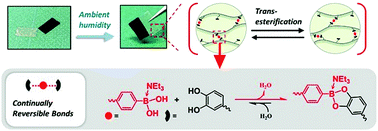Polymers with autonomous self-healing ability and remarkable reprocessability under ambient humidity conditions†
Abstract
The use of moisture in self-healing polymeric materials is a very attractive option given the practical environments in which the materials are used. Herein, we incorporated tetrahedral boronate-esters bearing B–N dative bonds as dynamic crosslinks into polymers, which led to moisture-induced self-healing abilities in their bulk states. Owing to the higher rate of ester formation over tetrahedral boronate-ester hydrolysis under wet conditions, these polymers invariably maintain a sufficient number of dynamic crosslinks to facilitate a combination of autonomous healing behavior and mechanical strength, which makes them unique compared to other previously developed water-triggered self-healing polymers. The self-healed materials maintain good mechanical properties, with fracture stresses of ∼2 MPa, and ageing of the cut surfaces does not affect their healing efficiency. Furthermore, the tetrahedral boronate-ester bonds exhibit dual stimuli-responsive dynamic behavior triggered by either moisture or heat, resulting in network polymers with remarkable reprocessabilities.



 Please wait while we load your content...
Please wait while we load your content...